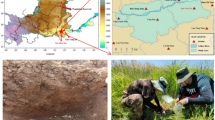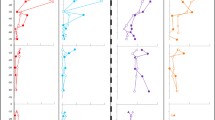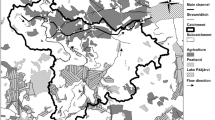Abstract
In constructed wetlands (CW), denitrification usually accounts for > 60% of nitrogen removal and is supposedly affected by wetland management practices, such as dredging (and plant removal). These practices cause an impact in sediment properties and microbial communities living therein. We have quantified the effects of a sediment dredging event on dissimilatory nitrite reduction by analysing the structure and activities of the microbial community before and after the event. Potential rates for nitrate reduction to ammonia and denitrification were in accordance with changes in the physicochemical conditions. Denitrification was the predominant pathway for nitrite removal (> 60%) and eventually led to the complete removal of nitrate. On the contrary, dissimilatory nitrite reduction to ammonia (DNRA) increased from 5 to 18% after the dredging event. Both actual activities and abundances of 16S rRNA, nirK and nirS significantly decreased after sediment dredging. However, genetic potential for denitrification (qnirS + qnirK/q16S rRNA) remained unchanged. Analyses of the 16S rRNA gene sequences revealed the importance of vegetation in shaping microbial community structures, selecting specific phylotypes potentially contributing to the nitrogen cycle. Overall, we confirmed that sediment dredging and vegetation removal exerted a measurable effect on the microbial community, but not on potential nitrite + nitrate removal rates. According to redundancy analysis, nitrate concentration and pH were the main variables affecting sediment microbial communities in the Empuriabrava CWs. Our results highlight a high recovery of the functionality of an ecosystem service after a severe intervention and point to metabolic redundancy of denitrifiers. We are confident these results will be taken into account in future management strategies in CWs.







Similar content being viewed by others
References
Vymazal J (2007) Removal of nutrients in various types of constructed wetlands. Sci Total Environ 380:48–65. https://doi.org/10.1016/j.scitotenv.2006.09.014
Tiedje JM (1988) Ecology of denitrification and dissimilatory nitrate reduction to ammonium. Environ Microbiol Anaerobes 717:179–244
Zumft WG (1997) Cell biology and molecular basis of denitrification. Microbiol Mol Biol Rev 61:533–582
Burgin AJ, Hamilton SK (2007) Have we overemphasized the role of denitrification in aquatic ecosystems? A review of nitrate removal pathways. Front Ecol Environ 5:89–96. https://doi.org/10.1890/1540-9295(2007)5[89:HWOTRO]2.0.CO;2
Koop-Jakobsen K, Giblin AE (2010) The effect of increased nitrate loading on nitrate reduction via denitrification and DNRA in salt marsh sediments. Limnol Oceanogr 55:789–802. https://doi.org/10.4319/lo.2009.55.2.0789
García-Lledó A, Ruiz-rueda O, Vilar-Sanz A et al (2011) Nitrogen removal efficiencies in a free water surface constructed wetland in relation to plant coverage. Ecol Eng 37:678–684
van Oostrom AJ, Russell JM (1994) Denitrification in constructed wastewater wetlands receiving high concentrations of nitrate. Water Sci Technol 29:7–14
Scott JT, McCarthy MJ, Gardner WS, Doyle RD (2008) Denitrification, dissimilatory nitrate reduction to ammonium, and nitrogen fixation along a nitrate concentration gradient in a created freshwater wetland. Biogeochemistry 87:99–111. https://doi.org/10.1007/s10533-007-9171-6
Wenk CB, Blees J, Zopfi J, Veronesi M, Bourbonnais A, Schubert CJ, Niemann H, Lehmann MF (2013) Anaerobic ammonium oxidation (anammox) bacteria and sulfide-dependent denitrifiers coexist in the water column of a meromictic south-alpine lake. Limnol Oceanogr 58:1–12. https://doi.org/10.4319/lo.2013.58.1.0001
Kim H, Bae H-S, Reddy KR, Ogram A (2016) Distributions, abundances and activities of microbes associated with the nitrogen cycle in riparian and stream sediments of a river tributary. Water Res 106:51–61. https://doi.org/10.1016/J.WATRES.2016.09.048
Lee C, Fletcher TD, Sun G (2009) Nitrogen removal in constructed wetland systems. Eng Life Sci 9:11–22. https://doi.org/10.1002/elsc.200800049
Jahangir MMR, Fenton O, Gill L, Müller C, Johnston P, Richards KG (2014) Carbon and nitrogen dynamics and greenhouse gases emissions in constructed wetlands: a review. Hydrol Earth Syst Sci Discuss 11:7615–7657. https://doi.org/10.5194/hessd-11-7615-2014
Vymazal J (2011) Constructed wetlands for wastewater treatment: five decades of experience. Environ Sci Technol 45:61–69. https://doi.org/10.1021/es101403q
Giblin AE, Weston NB, Banta GT, Tucker J, Hopkinson CS (2010) The effects of salinity on nitrogen losses from an oligohaline estuarine sediment. Estuar Coasts 33:1054–1068. https://doi.org/10.1007/s12237-010-9280-7
Lin X, McKinley J, Resch CT, Kaluzny R, Lauber CL, Fredrickson J, Knight R, Konopka A (2012) Spatial and temporal dynamics of the microbial community in the Hanford unconfined aquifer. ISME J 6:1665–1676. https://doi.org/10.1038/ismej.2012.26
Stottmeister U, Wießner A, Kuschk P, Kappelmeyer U, Kästner M, Bederski O, Müller RA, Moormann H (2003) Effects of plants and microorganisms in constructed wetlands for wastewater treatment. Biotechnol Adv 22:93–117. https://doi.org/10.1016/j.biotechadv.2003.08.010
Truu M, Juhanson J, Truu J (2009) Microbial biomass, activity and community composition in constructed wetlands. Sci Total Environ 407:3958–3971. https://doi.org/10.1016/j.scitotenv.2008.11.036
Ibekwe AM, Lyon SR, Leddy M, Jacobson-Meyers M (2007) Impact of plant density and microbial composition on water quality from a free water surface constructed wetland. J Appl Microbiol 102:921–936. https://doi.org/10.1111/j.1365-2672.2006.03181.x
Srivastava JK, Chandra H, Kalra SJS, Mishra P, Khan H, Yadav P (2017) Plant–microbe interaction in aquatic system and their role in the management of water quality: a review. Appl Water Sci 7:1079–1090. https://doi.org/10.1007/s13201-016-0415-2
Shelef O, Gross A, Rachmilevitch S (2013) Role of plants in a constructed wetland: current and new perspectives. Water (Switzerland) 5:405–419. https://doi.org/10.3390/w5020405
Chen Y, Zhou W, Li Y, Zhang J, Zeng G, Huang A, Huang J (2014) Nitrite reductase genes as functional markers to investigate diversity of denitrifying bacteria during agricultural waste composting. Appl Microbiol Biotechnol 98:4233–4243. https://doi.org/10.1007/s00253-014-5514-0
Fazzolari É, Nicolardot B, Germon JC (1998) Simultaneous effects of increasing levels of glucose and oxygen partial pressures on denitrification and dissimilatory nitrate reduction to ammonium in repacked soil cores. Eur J Soil Biol 34:47–52
Nizzoli D, Carraro E, Nigro V, Viaroli P (2010) Effect of organic enrichment and thermal regime on denitrification and dissimilatory nitrate reduction to ammonium (DNRA) in hypolimnetic sediments of two lowland lakes. Water Res 44:2715–2724. https://doi.org/10.1016/j.watres.2010.02.002
Thullen JS, Sartoris JJ, Walton WE (2002) Effects of vegetation management in constructed wetland treatment cells on water quality and mosquito production. Ecol Eng 18:441–457. https://doi.org/10.1016/S0925-8574(01)00105-7
Griffiths BS, Philippot L (2013) Insights into the resistance and resilience of the soil microbial community. FEMS Microbiol Rev 37:112–129. https://doi.org/10.1111/j.1574-6976.2012.00343.x
Ligi T, Oopkaup K, Truu M, Preem JK, Nõlvak H, Mitsch WJ, Mander Ü, Truu J (2014) Characterization of bacterial communities in soil and sediment of a created riverine wetland complex using high-throughput 16S rRNA amplicon sequencing. Ecol Eng 72:56–66. https://doi.org/10.1016/j.ecoleng.2013.09.007
Smith JM, Ogram A (2008) Genetic and functional variation in denitrifier populations along a short-term restoration chronosequence. Appl Environ Microbiol 74:5615–5620. https://doi.org/10.1128/AEM.00349-08
Ruiz-Rueda O, Trias R, Garcia-gil LJ, Bañeras L (2007) Diversity of the nitrite reductase gene nirS in the sediment of a free-water surface constructed wetland. Int Microbiol 10:253–260. https://doi.org/10.2436/20.1501.01.34
Ruiz-Rueda O, Hallin S, Bañeras L (2009) Structure and function of denitrifying and nitrifying bacterial communities in relation to the plant species in a constructed wetland. FEMS Microbiol Ecol 67:308–319. https://doi.org/10.1111/j.1574-6941.2008.00615.x
Hallin S, Jones CM, Schloter M, Philippot L (2009) Relationship between N-cycling communities and ecosystem functioning in a 50-year-old fertilization experiment. ISME J 3:597–605. https://doi.org/10.1038/ismej.2008.128
Welsh A, Chee-Sanford JC, Connor LM, Löffler FE, Sanford RA (2014) Refined NrfA phylogeny improves PCR-based nrfA gene detection. Appl Environ Microbiol 80:2110–2119. https://doi.org/10.1128/AEM.03443-13
Humbert S, Zopfi J, Tarnawski S-E (2012) Abundance of anammox bacteria in different wetland soils. Environ Microbiol Rep 4:484–490. https://doi.org/10.1111/j.1758-2229.2012.00347.x
Mardis ER (2008) Next-generation DNA sequencing methods. Annu Rev Genomics Hum Genet 9:387–402. https://doi.org/10.1146/annurev.genom.9.081307.164359
Caporaso JG, Kuczynski J, Stombaugh J, Bittinger K, Bushman FD, Costello EK, Fierer N, Peña AG, Goodrich JK, Gordon JI, Huttley GA, Kelley ST, Knights D, Koenig JE, Ley RE, Lozupone CA, McDonald D, Muegge BD, Pirrung M, Reeder J, Sevinsky JR, Turnbaugh PJ, Walters WA, Widmann J, Yatsunenko T, Zaneveld J, Knight R (2010) QIIME allows analysis of high-throughput community sequencing data. Nat Methods 7:335–336. https://doi.org/10.1038/nmeth.f.303
Edgar RC (2016) UNOISE2: improved error-correction for Illumina 16S and ITS amplicon sequencing. bioRxiv. https://doi.org/10.1101/081257
Schloss PD (2008) Evaluating different approaches that test whether microbial communities have the same structure. ISME J 2:265–275. https://doi.org/10.1038/ismej.2008.5
Clarke KR, Warwick RM (2001) Change in marine communities. An approach to statistical analysis and interpretation.2nd edn. Plymouth Marine Laboratory, Plymouth
Dufrene M, Legendre P (1997) Species assemblages and indicator species: the need for a flexible asymmetrical approach. Ecol Monogr 67:345. https://doi.org/10.2307/2963459
Zhang J, Liu B, Zhou X, Chu J, Li Y, Wang M (2015) Effects of emergent aquatic plants on abundance and community structure of ammonia-oxidising microorganisms. Ecol Eng 81:504–513. https://doi.org/10.1016/J.ECOLENG.2015.04.029
Li Y, Wu B, Zhu G, Liu Y, Ng WJ, Appan A, Tan SK (2016) High-throughput pyrosequencing analysis of bacteria relevant to cometabolic and metabolic degradation of ibuprofen in horizontal subsurface flow constructed wetlands. Sci Total Environ 562:604–613. https://doi.org/10.1016/J.SCITOTENV.2016.04.020
Van Der Zaan B, Smidt H, De Vos WM et al (2010) Stability of the total and functional microbial communities in river sediment mesocosms exposed to anthropogenic disturbances. FEMS Microbiol Ecol 74:72–82. https://doi.org/10.1111/j.1574-6941.2010.00931.x
Jangid K, Williams MA, Franzluebbers AJ, Sanderlin JS, Reeves JH, Jenkins MB, Endale DM, Coleman DC, Whitman WB (2008) Relative impacts of land-use, management intensity and fertilization upon soil microbial community structure in agricultural systems. Soil Biol Biochem 40:2843–2853. https://doi.org/10.1016/J.SOILBIO.2008.07.030
Röske K, Sachse R, Scheerer C, Röske I (2012) Microbial diversity and composition of the sediment in the drinking water reservoir Saidenbach (Saxonia, Germany). Syst Appl Microbiol 35:35–44. https://doi.org/10.1016/J.SYAPM.2011.09.002
Wang Y, Sheng H-F, He Y, Wu JY, Jiang YX, Tam NFY, Zhou HW (2012) Comparison of the levels of bacterial diversity in freshwater, intertidal wetland, and marine sediments by using millions of Illumina tags. Appl Environ Microbiol 78:8264–8271. https://doi.org/10.1128/AEM.01821-12
Ansola G, Arroyo P, Sáenz de Miera LE (2014) Characterisation of the soil bacterial community structure and composition of natural and constructed wetlands. Sci Total Environ 473:63–71. https://doi.org/10.1016/j.scitotenv.2013.11.125
Zhou Z, Meng H, Liu Y, Gu JD, Li M (2017) Stratified bacterial and archaeal community in mangrove and intertidal wetland mudflats revealed by high throughput 16S rRNA gene sequencing. Front Microbiol 8:2148. https://doi.org/10.3389/fmicb.2017.02148
Andreote FD, Jiménez DJ, Chaves D, Dias ACF, Luvizotto DM, Dini-Andreote F, Fasanella CC, Lopez MV, Baena S, Taketani RG, de Melo IS (2012) The microbiome of Brazilian mangrove sediments as revealed by metagenomics. PLoS One 7:e38600. https://doi.org/10.1371/journal.pone.0038600
Miao L, Liu Z (2018) Microbiome analysis and -omics studies of microbial denitrification processes in wastewater treatment: recent advances. Sci China Life Sci 61:753–761. https://doi.org/10.1007/s11427-017-9228-2
Si Z, Song X, Wang Y, Cao X, Zhao Y, Wang B, Chen Y, Arefe A (2018) Intensified heterotrophic denitrification in constructed wetlands using four solid carbon sources: denitrification efficiency and bacterial community structure. Bioresour Technol 267:416–425. https://doi.org/10.1016/J.BIORTECH.2018.07.029
Shoun H, Kano M, Baba I, Takaya N, Matsuo M (1998) Denitrification by actinomycetes and purification of dissimilatory nitrite reductase and azurin from Streptomyces thioluteus. J Bacteriol 180:4413–4415
Rifaat HM, Márialigeti K, Kovács G (2000) Investigation on rhizoplane actinomycete communities of cattail (Typha angustifolia) from a Hungarian wetland. SUO 51:197–203
Duarte Pereira A, Dutra Leal C, França Dias M et al (2014) Effect of phenol on the nitrogen removal performance and microbial community structure and composition of an anammox reactor. Bioresour Technol 166:103–111. https://doi.org/10.1016/j.biortech.2014.05.043
Akaboci TRV, Gich F, Ruscalleda M, Balaguer MD, Colprim J (2018) Assessment of operational conditions towards mainstream partial nitritation-anammox stability at moderate to low temperature: reactor performance and bacterial community. Chem Eng J 350:192–200. https://doi.org/10.1016/J.CEJ.2018.05.115
Tamaki H, Sekiguchi Y, Hanada S, Nakamura K, Nomura N, Matsumura M, Kamagata Y (2005) Comparative analysis of bacterial diversity in freshwater sediment of a shallow eutrophic lake by molecular and improved cultivation-based techniques. Appl Environ Microbiol 71:2162–2169. https://doi.org/10.1128/AEM.71.4.2162-2169.2005
Ishii S, Yamamoto M, Kikuchi M, Oshima K, Hattori M, Otsuka S, Senoo K (2009) Microbial populations responsive to denitrification-inducing conditions in rice paddy soil, as revealed by comparative 16S rRNA gene analysis. Appl Environ Microbiol 75:7070–7078. https://doi.org/10.1128/AEM.01481-09
Hoffmann T, Frankenberg N, Marino M, Jahn D (1998) Ammonification in Bacillus subtilis utilizing dissimilatory nitrite reductase is dependent on resDE. J Bacteriol 180:186–189
Verbaendert I, Boon N, De Vos P, Heylen K (2011) Denitrification is a common feature among members of the genus Bacillus. Syst Appl Microbiol 34:385–391. https://doi.org/10.1016/J.SYAPM.2011.02.003
Jones CM, Hallin S (2010) Ecological and evolutionary factors underlying global and local assembly of denitrifier communities. ISME J 4:633–641. https://doi.org/10.1038/ismej.2009.152
Lindemann S, Zarnoch CB, Castignetti D, Hoellein TJ (2015) Effect of eastern oysters (Crassostrea virginica) and seasonality on nitrite reductase gene abundance (nirS, nirK, nrfA) in an urban estuary. Estuar Coasts 39:218–232. https://doi.org/10.1007/s12237-015-9989-4
Penton CR, St Louis D, Pham A et al (2015) Denitrifying and diazotrophic community responses to artificial warming in permafrost and tallgrass prairie soils. Front Microbiol 6:746. https://doi.org/10.3389/fmicb.2015.00746
Fierer N, Jackson RB (2006) The diversity and biogeography of soil bacterial communities. Proc Natl Acad Sci U S A 103:626–631. https://doi.org/10.1073/pnas.0507535103
Ligi T, Truu M, Truu J, Nõlvak H, Kaasik A, Mitsch WJ, Mander Ü (2014) Effects of soil chemical characteristics and water regime on denitrification genes (nirS, nirK, and nosZ) abundances in a created riverine wetland complex. Ecol Eng 72:47–55. https://doi.org/10.1016/j.ecoleng.2013.07.015
García-Lledó A, Vilar-Sanz A, Trias R, Hallin S, Bañeras L (2011) Genetic potential for N2O emissions from the sediment of a free water surface constructed wetland. Water Res 45:5621–5632. https://doi.org/10.1016/j.watres.2011.08.025
Helen D, Kim H, Tytgat B, Anne W (2016) Highly diverse nirK genes comprise two major clades that harbour ammonium-producing denitrifiers. BMC Genomics 17:155. https://doi.org/10.1186/s12864-016-2465-0
Dong LF, Smith CJ, Papaspyrou S, Stott A, Osborn AM, Nedwell DB (2009) Changes in benthic denitrification, nitrate ammonification, and anammox process rates and nitrate and nitrite reductase gene abundances along an estuarine nutrient gradient (the Colne estuary, United Kingdom). Appl Environ Microbiol 75:3171–3179. https://doi.org/10.1128/AEM.02511-08
Hernández-del Amo E, Menció A, Gich F, Mas-Pla J, Bañeras L (2018) Isotope and microbiome data provide complementary information to identify natural nitrate attenuation processes in groundwater. Sci Total Environ 613–614:579–591. https://doi.org/10.1016/j.scitotenv.2017.09.018
Friedl J, De Rosa D, Rowlings DW et al (2018) Dissimilatory nitrate reduction to ammonium (DNRA), not denitrification dominates nitrate reduction in subtropical pasture soils upon rewetting. Soil Biol Biochem 125:340–349. https://doi.org/10.1016/J.SOILBIO.2018.07.024
Rahman MM, Roberts KL, Warry F, Grace MR, Cook PLM (2019) Factors controlling dissimilatory nitrate reduction processes in constructed stormwater urban wetlands. Biogeochemistry 142:375–393. https://doi.org/10.1007/s10533-019-00541-0
Rütting T, Boeckx P, Müller C, Klemedtsson L (2011) Assessment of the importance of dissimilatory nitrate reduction to ammonium for the terrestrial nitrogen cycle. Biogeosciences 8:1779–1791. https://doi.org/10.5194/bg-8-1779-2011
McKew BA, Taylor JD, McGenity TJ, Underwood GJC (2011) Resistance and resilience of benthic biofilm communities from a temperate saltmarsh to desiccation and rewetting. ISME J 5:30–41. https://doi.org/10.1038/ismej.2010.91
Mohit V, Archambault P, Lovejoy C (2015) Resilience and adjustments of surface sediment bacterial communities in an enclosed shallow coastal lagoon, Magdalen Islands, Gulf of St. Lawrence, Canada. FEMS Microbiol Ecol 91:fiv038. https://doi.org/10.1093/femsec/fiv038
Acknowledgements
The authors are grateful to Lluís Sala Genoher (Consorci d’Aigües Costa Brava, www.ccbgi.org) and the personnel at the EDAR-Empuriabrava for providing field data and access to the sampling area. Ariadna Vilar-Sanz and Laia Mauricio are acknowledged for assisting in field work and initial processing of samples.
Funding
EHdA received a grant from the University of Girona (IF-UDG2013). This work was funded by the Spanish Ministry (CGL2009-08338/BOS) and the University of Girona (MPCUdG2016/121). IEA has been recognised as a consolidated research group by the Catalan Government (2017SGR-548).
Author information
Authors and Affiliations
Contributions
All authors conceived and planned the experiments. EHdA, SRP and FG carried out the experiments. EHdA, FG, SRP, LB and RT assisted in field work. EHdA and SRP prepared the samples and performed chemical and kinetic determinations. EHdA, FG and RT conducted molecular work. EHdA, FG and LB contributed to the interpretation of the results. EHdA drafted the manuscript. All authors contributed to the discussion and review of the manuscript providing critical feedback. LB and FG approved the submission.
Corresponding author
Ethics declarations
Conflict of Interest
The authors declare that they have no conflict of interest.
Electronic Supplementary Material
ESM 1
(DOCX 2047 kb)
Rights and permissions
About this article
Cite this article
Hernández-del Amo, E., Ramió-Pujol, S., Gich, F. et al. Changes in the Potential Activity of Nitrite Reducers and the Microbial Community Structure After Sediment Dredging and Plant Removal in the Empuriabrava FWS-CW. Microb Ecol 79, 588–603 (2020). https://doi.org/10.1007/s00248-019-01425-4
Received:
Accepted:
Published:
Issue Date:
DOI: https://doi.org/10.1007/s00248-019-01425-4




